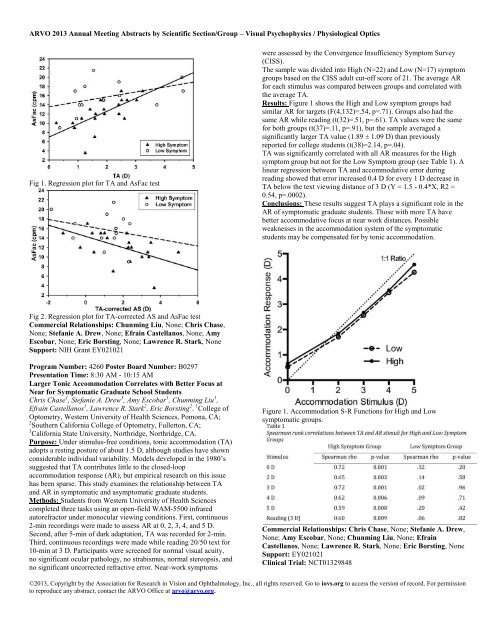Visual Psychophysics / Physiological Optics - ARVO
Visual Psychophysics / Physiological Optics - ARVO
Visual Psychophysics / Physiological Optics - ARVO
Create successful ePaper yourself
Turn your PDF publications into a flip-book with our unique Google optimized e-Paper software.
<strong>ARVO</strong> 2013 Annual Meeting Abstracts by Scientific Section/Group – <strong>Visual</strong> <strong>Psychophysics</strong> / <strong>Physiological</strong> <strong>Optics</strong>Fig 1. Regression plot for TA and AsFac testwere assessed by the Convergence Insufficiency Symptom Survey(CISS).The sample was divided into High (N=22) and Low (N=17) symptomgroups based on the CISS adult cut-off score of 21. The average ARfor each stimulus was compared between groups and correlated withthe average TA.Results: Figure 1 shows the High and Low symptom groups hadsimilar AR for targets (F(4,132)=.54, p=.71). Groups also had thesame AR while reading (t(32)=.51, p=.61). TA values were the samefor both groups (t(37)=.11, p=.91), but the sample averaged asignificantly larger TA value (1.89 ± 1.09 D) than previouslyreported for college students (t(38)=2.14, p=.04).TA was significantly correlated with all AR measures for the Highsymptom group but not for the Low Symptom group (see Table 1). Alinear regression between TA and accommodative error duringreading showed that error increased 0.4 D for every 1 D decrease inTA below the text viewing distance of 3 D (Y = 1.5 - 0.4*X, R2 =0.54, p=.0002).Conclusions: These results suggest TA plays a significant role in theAR of symptomatic graduate students. Those with more TA havebetter accommodative focus at near work distances. Possibleweaknesses in the accommodation system of the symptomaticstudents may be compensated for by tonic accommodation.Fig 2. Regression plot for TA-corrected AS and AsFac testCommercial Relationships: Chunming Liu, None; Chris Chase,None; Stefanie A. Drew, None; Efrain Castellanos, None; AmyEscobar, None; Eric Borsting, None; Lawrence R. Stark, NoneSupport: NIH Grant EY021021Program Number: 4260 Poster Board Number: B0297Presentation Time: 8:30 AM - 10:15 AMLarger Tonic Accommodation Correlates with Better Focus atNear for Symptomatic Graduate School StudentsChris Chase 1 , Stefanie A. Drew 3 , Amy Escobar 1 , Chunming Liu 1 ,Efrain Castellanos 1 , Lawrence R. Stark 2 , Eric Borsting 2 . 1 College ofOptometry, Western University of Health Sciences, Pomona, CA;2 Southern California College of Optometry, Fullerton, CA;3 California State University, Northridge, Northridge, CA.Purpose: Under stimulus-free conditions, tonic accommodation (TA)adopts a resting posture of about 1.5 D, although studies have shownconsiderable individual variability. Models developed in the 1980’ssuggested that TA contributes little to the closed-loopaccommodation response (AR), but empirical research on this issuehas been sparse. This study examines the relationship between TAand AR in symptomatic and asymptomatic graduate students.Methods: Students from Western University of Health Sciencescompleted three tasks using an open-field WAM-5500 infraredautorefractor under monocular viewing conditions. First, continuous2-min recordings were made to assess AR at 0, 2, 3, 4, and 5 D.Second, after 5-min of dark adaptation, TA was recorded for 2-min.Third, continuous recordings were made while reading 20/50 text for10-min at 3 D. Participants were screened for normal visual acuity,no significant ocular pathology, no strabismus, normal stereopsis, andno significant uncorrected refractive error. Near-work symptomsFigure 1. Accommodation S-R Functions for High and Lowsymptomatic groups.Commercial Relationships: Chris Chase, None; Stefanie A. Drew,None; Amy Escobar, None; Chunming Liu, None; EfrainCastellanos, None; Lawrence R. Stark, None; Eric Borsting, NoneSupport: EY021021Clinical Trial: NCT01329848©2013, Copyright by the Association for Research in Vision and Ophthalmology, Inc., all rights reserved. Go to iovs.org to access the version of record. For permissionto reproduce any abstract, contact the <strong>ARVO</strong> Office at arvo@arvo.org.
















